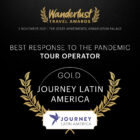Market Mayhem

"Eight? You want eight for it?" "Si, señor, precio muy bueno. Precio especial." "Eight isn’t ‘especial’! How about two for ten, that’s especial." "Dos por diez? No, no, no, no..." "Come on, ten for two. You’re not going to sell anything at eight for one." "Ay, bueno... Hecho. Dos por diez." Hecho. Done. And so another transaction is concluded at Otavalo’s market.
Although some people dislike haggling, others enjoy the interaction and joviality of it. Personally, I love nothing more than haggling good-naturedly over a sweater, panpipe or fake precolumbian trinket. And such is the range and quality of the produce on sale at Otavalo, after a few hours of buying, you’ll be forced to haggle: you’ll have no money left!
In the early morning, in a field on the outskirts of town, a different type of haggling takes place. At the animal market, you enter through a hole in the barbed wire fence where officials tax the buyers 20 cents on every purchase. You’re immediately squelching in the mud of hundreds of trotters and barefooted indians, as swine ranging from the squealing weeks-old piglet to the mammoth 160-kilo hog are inspected, haggled over and eventually sold.
Indian women tether cords which fan out to runts of piglets happily rooting around in the mud for scraps, while mestizo families throw pigs out of the back of their vans to buyers who prise the poor animals’ jaws open with crowbars below. After the pigs come the sheep, huddled in bleating flocks around their owners, and then the cows and the occasional bull of all sizes and colours, insouciantly splurging cowpats and urinating while their masters decide their fates. None of the locals pay the odd tourist the slightest bit of attention.
I went around talking to the peasants, asking them where they were from, how much they expected their cow to fetch, and what the weather was going to do. Most of them, weather-burnished and ragged-toothed, still talked in sucres, Ecuador's old currency, even though it was over a year since the economy was ‘dollarised’. In the mêlée, I spotted a woman who had a sheep instead of a baby slung around her back, and another clasping two large cockerels beneath her ample bosom, only their heads and claws emerging from the folds of her embroidered, billowing blouse.
Later, I made my way to the main tourist market at the Plaza de los Ponchos, muffled by stalls. On Saturdays, hundreds of stands plug the avenues leading to the square, the ones running east slowly becoming less touristy, dominated by pots and pans and tupperware, until you reach the arcades of the produce market, jammed with piles of every variety of fruit, vegetable, fish and meat. The weavings are beautiful, ranging from rugs of symmetric red, brown and blue patterns, dark tightly-woven ponchos, bright woolly hats festooned with flowers, the oranges, yellows and greens of hammocks, through to quite westernised sweaters and zip-up tops of just a few colours.
To add to the textiles, stalls also overflow with musical instruments (those infernal whirly drum things and the inevitable panpipes); intricately-painted ceramic bowls; miniature paintings from the indians of Tigua, masters of representing their world of puffing volcanoes, fluffy llamas and busying locals; wood carvings of jagged-jowled men; and jewellery of every size and description. Although undeniably a tourist trap, the quality of the crafts on sale at Otavalo is so high most people don’t mind feeling like another gringo.
Otavalo hosts probably the most famous tourists’ market in South America, and most definitely Ecuador’s most important. The Otavalan indians, the women instantly recognizable by the layers of gold necklaces which throng their necks, are renowned for their textiles and weaving, but also for their business acumen and ambition. They rank among the continent’s most prosperous indigenous people, proud of their heritage - they still wear their traditional dress - and yet able to take advantage of the tourist dollar.
As well as visiting the markets, I would suggest you take a tour of the surrounding villages to meet the families of weavers and learn more about their craft. The most well-known are José Cotacachi in Peguchi, Miguel Andrango in Agato, and the Inti-Chumbi cooperative of Ilumán.
For tourist produce, Otavalo stands head and shoulders above any other highland town. But what the others lack in souvenirs they make up for in authenticity and local colour.
To the south of Quito, three markets take place on different days in the towns of Saquisilí (Thursday), Zumbahua (Saturday) and Pujilí (Sunday).
By staying in the Latacunga area you can visit all three. In the central and southern sierra, all the major towns spring to bustling, colourful life for their market days. South West of Riobamba on Sundays, one of the most unique markets takes place at Cajabamba. The highland Colta Indians dispense with any roofs or structures, and simply hold their age-old market by the side of the Panamerican Highway.
Beginning at dawn, indians from surrounding villages make their way to the towns’ squares. Bent double, they carry Sisyphean sacks stuffed with potatoes or onions on their backs, herd their sheep along the roadsides, drag their pigs down the cobbles, transport their hens in wooden crates or sacks poked with holes filled with pecking heads and haul tables, benches, pots and pans to their favoured spot on the square, where they set up their impromptu, open-air restaurants.
The joy of visiting these markets is the opportunity to be a part of the chaos, noise and hubbub, to wonder at all the strange fruits, vegetables and unidentified pieces of meat floating in bubbling stews. It’s to observe the dress-code of the villagers: does the black poncho on that man mean he’s from Salasaca? Does the wide white felt hat on that woman come from Saquisilí or Saraguro? The indian names of these places are as elegant as the costumes of those that live there. You can watch them haggle over guinea pigs, laugh about misfortune, and gossip about the latest scandal or the price of milk.
It’s to step into the lives of the highland indians, and also back in time: markets have been held in the highland towns and villages since time immemorial.
Tailor-made holidays
Flexible, custom-made holidays to Latin America created to match your exact requirements: our tailor-made itineraries are as unique as the clients for whom they are designed.
Design my trip


























